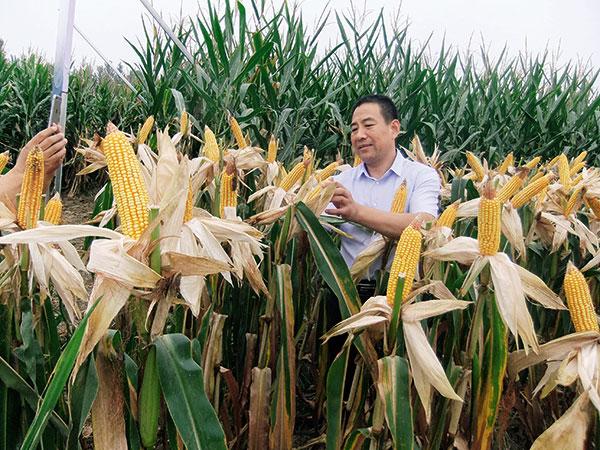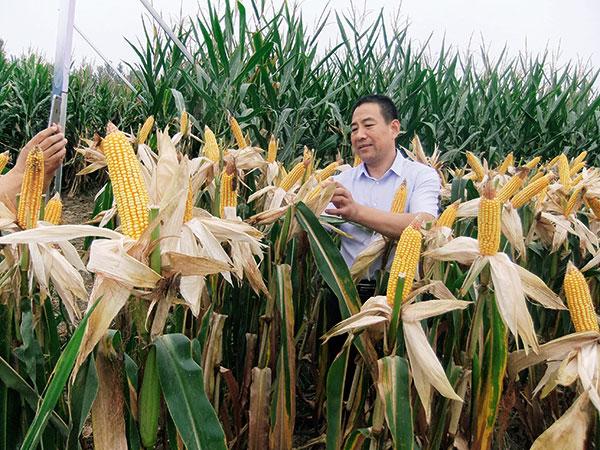ang Yongfu received the Star of Science Medal from the International Academy of Ecology and Life Protection Sciences in late 2015 for his contribution to the reduction of agricultural “secondary disasters” – the downstream damage caused by farming practices. But despite the honors, he remains a typical Chinese farmer: reticent, persistent, simple and honest. On the wall of his office hangs a piece of his own calligraphy reading “Be devoted to the reduction of rural disasters.”
When talking about soil degradation in China, Dang, 50, appears more upset and concerned than ever, saying repeatedly that “our soil is ill, very ill.” “The organic matter content of the soil used to be 6.7 percent, but nowadays it has dropped to 0.8 to 1.5 percent,” he warned. “Chinese farmers have increased their use of fertilizers and pesticides over the years, but the output remains virtually stable.”
Official statistics show that as of the end of 2013, over 16 percent of soil in China was polluted, including 2.6 percent being heavily polluted. To make matters worse, nearly 20 percent of China’s almost 120 million hectares of arable land was polluted. In 2015, 3.74 million tons of pesticides were used nationwide, up from 2.21 million tons in 1993. Meanwhile, 65 million tons of fertilizers were applied in 2013, up from 8.84 million tons in 1978.
Dang said that taking action to reduce the side-effects and overuse of pesticides and fertilizers in order to restore polluted farmland is an urgent problem for China. “There is no time to wait anymore,” he told NewsChina.
Immersion
Dang’s first exposure to herbicides was 28 years ago when he was a farmer in Shangshui County in Henan Province. His brother gave him a pack of herbicides. At that time, very few farmers used herbicides and Dang was curious to know whether the stuff would affect crop growth. He decided to conduct an experiment on two pieces of farmland – in one he used herbicides, in the other he stuck to manual weeding.
Several months later, he was surprised to find that herbicides were very effective in weeding but that the wheat crop grew more slowly and the yield was less than that of the other plot. He was concerned that if herbicides were used nationwide, yields would drop accordingly. That was when Dang began to start his research on the reduction of the side effects of herbicides.
He experimented with nearly every traditional method supposed to have detoxification properties, including green bean water, garlic water and even some traditional Chinese medicine preparations.
“He was mad back then and even had the idea of pouring meat soup onto the land to see what would happen,” Qiu Yinzhi, Dang’s wife, told NewsChina.
After repeated failures, Dang turned to books on the subject to continue his study and spent years visiting scholars and researchers in the field. Some of them were puzzled by his actions and said that it was too early to reduce the side effects of herbicides when they were not yet widely used in China. Some agricultural scientists even recommended him to produce herbicides, promising that it would soon be a lucrative business.
Dang said he was moved by the market potential but after many field trips to chemical factories, he gave up his experiments. “Herbicide enterprises were huge polluters and the underground water in areas adjoining the factories tasted bitter and strange. I would never start it as a business,” he said.
Chen Chang, a senior engineer with the Shenyang Research Institute of Chemical Industry in northeastern Liaoning Province, was a great help to Dang’s research on reducing the side effects of herbicides. To persuade Chen to join his research, Dang went to Shenyang and sat outside the door of Chen’s home until, within half a year, Chen consented. Shortly after they started collaborating in Dang’s hometown, however, Chen suddenly died of a cerebral hemorrhage. It was a shock to Dang because he was then mainly responsible for building up the enterprise and Chen had been the chief technical adviser.
When gathering Chen’s belongings, Dang happened to find a list of numbers on a cigarette case that turned out to be the refinement and mixture ratios of several chemical substances which would be part of his future research. He decided to make a go of it alone. After three years and hundreds of experiments, he eventually developed an additive in 2001 that made herbicides safer. After that, Dang devoted his research to chemical fertilizers and successfully developed an organic amino acid water-soluble fertilizer that can diminish pollution to soil and water, improve organic matter content and loosen the soil.
In January 2007, Henan’s provincial government carried out a technical evaluation of Dang’s herbicide safety additive, saying it had filled a technical blank for the country, had reached an advanced international level and had great market potential.
Dang said that herbicides are now used on around 100 million hectares nationwide and the use of herbicide safety additives could increase crop output by 75 million tons annually, enough to feed 375 million people. If his fertilizers were used nationwide, crop output could be increased by 8 percent and fertilizer consumption could be reduced by a third, saving 19.5 million tons of fertilizer each year.
Challenges
In 2003 when Dang tried to register his herbicide additives at government agencies, he came to realize that this was even more difficult than the research. An employee at an agriculture-related government organization repeatedly refused his applications and informed him that his additives were neither pesticides, nor chemical fertilizers and certainly not agricultural machinery, making them impossible to register under any category. It was also difficult for Dang to register his fertilizers and it was not until several years later that his fertilizers were added to the official list by the National Fertilizer Management Authority, thanks to his persistence.
Dang was often puzzled as to why his inventions could not gain government support, even though they had proved to be effective and his fertilizer could increase crop output by 50 million tons while reducing total fertilizer use by 20 million tons annually, cutting down the government expenditure on pollution control by at least 100 billion yuan (US$14.8 billion).
For instance, when he had an opportunity to discuss soil pollution treatments with several senior officials from the Ministry of Agriculture, he found that they attached great importance to the increase of crop output but were afraid that the reduction of the use of fertilizers and pesticides would affect crop yields. In addition, he came to realize that officials were very sensitive to statistics related to soil pollution and feared that Dang’s work would open a can of worms. Every time Dang attended an agricultural conference in China, organizers would tell him in advance not to speak his mind.
In 2012, the agricultural branch of the China Senior Professors Association delivered a report to the State Council, China’s cabinet, on the urgency of controlling the side effects of herbicides, but the expert group from several related government agencies replied in their counter report that “herbicides do not have any side effects.”
“Is it not obvious what the side effects of herbicides are and therefore what kind of experts these are, with their reckless judgment?” he said to NewsChina.
Dang found another incident even more saddening. In June 2016, when a national laboratory for farmland pollution alleviation was opened for applications, Dang’s research team went up against nine research institutes but failed to win the bid.
Dang told NewsChina that he has been working in the alleviation of soil pollution for 26 years and has gained rich experience in product research and manufacturing, gaining apparent advantages compared to the other research institutes. As a matter of fact, he added, the institute that secured the project had borrowed a lot from his research and facilities.
As Dang sees it, China’s established agricultural management mechanisms are proving decreasingly effective in solving current rural problems. Over the years, China’s scientific research has mainly been conducted in the laboratories of research institutes and little attention has been paid to the work of enterprises. The theoretical research conducted by experts from institutes, he added, is sometimes at odds with practical applications.
“China lacks a uniform standard in treating soil pollution, with the immediate consequence that some people are fishing in troubled waters,” he cautioned. “In rural areas, relations play a bigger role than technology.”
Dang said that China’s agricultural problems go well beyond the overuse of pesticides and fertilizers. In his book on the prevention and treatment of agricultural secondary disasters, he proposed in detail the challenges in agriculture both in China and abroad and offered his solutions from the perspective of policies, agricultural management and technical support. The book has been listed as a training textbook for junior technicians by the United Nations’ Human Settlements Program, UN-Habitat.
“It is unimaginable what will become of Chinese agriculture in 50 or 100 years if soil pollution problems are not addressed in time,” said Dang.

 Old Version
Old Version
